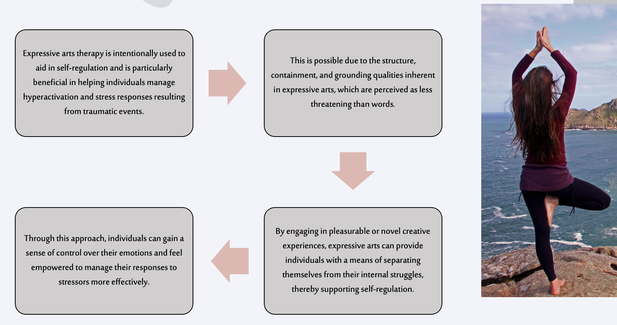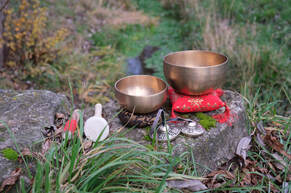Sensory Approaches
The expressive arts incorporate the senses into the creative process.
- The senses of sight, hearing, touch, smell, and taste enable us to perceive external stimuli, a process known as exteroception.
- Interoception refers to the perception of internal bodily sensations such as our pulse, breathing, and even pain. It also encompasses less concrete sensations like internal moods or intuition.
- Props may include: scented bags (essential oils, seasonings, coffee, tea leaves); edible finger paint (Crayola, diy w/ yogurt + food coloring); oil diffusers; tea or snacks; mindful eating
Self-Regulation
Sensorimotor Approaches: POSTER
Click here for a poster of 8 Sensory Experiences for Restoring the Self!
Nature Based TherapyNature therapy, or eco therapy, helps us to connect to our inner selves, the earth, and with others through "rooting" us to the natural environment around us. It supports personal growth, healing, and overall well-being, which is important to our mental health. Here are a few articles to help you explore how nature is being used in therapy.
|
Sight
Visual Journaling
“Art diaries” contain images and words through collage, photography, drawing, painting, scrapbooking or otherwise altering a journal to explore experiences (Gladdings, 2021, p.103).
Scribble Drawing
Beginning with rhythmic movement of the arms, the creator choose their media, and begins to “scribble” a continuous line until they feel complete. Then, the creator finds an area that resonates within the drawing, and expands upon it, followed by reflection (Randick, 2022). Example: https://www.youtube.com/watch?v=GN6C39KdnIU
“Art diaries” contain images and words through collage, photography, drawing, painting, scrapbooking or otherwise altering a journal to explore experiences (Gladdings, 2021, p.103).
Scribble Drawing
Beginning with rhythmic movement of the arms, the creator choose their media, and begins to “scribble” a continuous line until they feel complete. Then, the creator finds an area that resonates within the drawing, and expands upon it, followed by reflection (Randick, 2022). Example: https://www.youtube.com/watch?v=GN6C39KdnIU
Sound
Sound
Four ways sound affect us:
Four ways sound affect us:
- 1) Physiological; 2) Psychological; 3) Cognitively; 4) Behaviorally (2009)
- Ted Talk (Julian Treasure): https://www.youtube.com/watch?v=rRepnhXq33s&t=295s
- Think of your life as a musical
- Find sounds that reflect the highs and lows of your existence (using nature, vocal sounding, songs, instruments, etc.)
- What memories are evoked from writing down and listening?
- What titles would you want to create to represent the next ten years of life? (Gladdings, 2021, p.47)
Touch
Clay
“This is Me” is an exploration of a sitting with a feeling or combination of feelings, then expressing them through working with clay. Inviting options of eyes closed or opened, using dominant or nondominant hand (Rogers, 1993, pp.113-114).
Let’s Taco ‘Bout Feelings Taco Tuesday Make & Tel
“This is Me” is an exploration of a sitting with a feeling or combination of feelings, then expressing them through working with clay. Inviting options of eyes closed or opened, using dominant or nondominant hand (Rogers, 1993, pp.113-114).
Let’s Taco ‘Bout Feelings Taco Tuesday Make & Tel
- Group activity- encourage adolescent clients to talk about their feelings and emotions in a socializing and therapeutic group setting. Through various toppings labeled to represent different feelings and emotions, the client can add items or leave items off that represent how they are feeling or describe stressors.
- Then clients describe their tacos or taco salad, sharing why they chose their items and how it related to their feelings and emotions
- This socialization sparks creativity and encourages the client to find meaning in identifying his/her emotions (Elswick, 2019, pp.72-73).
Sound
- Clapper, J., Ware, S., Martinez, F. J., Benitez, K., & Koshino, H. (2021). Breath counting as a measure of sustained attention in mindfulness meditation and its effect on mood. Psychology of Consciousness: Theory, Research, and Practice. 1-28. https://doi.org/10.1037/cns0000311
- Coleman, K. (2020). Pit Fired Figure unglazed. [Clay Sculpture]. Saint Paul, MN; Private Collection.
- darkfoxelixir. (n.d.). Vecteezy. https://www.vecteezy.com/video/8241182-rainbow-sakura-flowers-fall-down-on-the-black-screen
- Espinosa, A., Morrison, R., Gonzalez, D., Jamardo, J., Fortuna, F., Díaz, C.-P., Gutiérrez, P., Frías, C., Soto, P., González, A., Mella, S., & Fabre, B. (2022). Effects of Occupational Therapy Program Based on Active Meditation on Hair Cortisol Levels in Undergraduate Healthcare Students. Occupational Therapy International, 1–7. https://doi.org/10.1155/2022/2174397
- Hans. (2022, May 18). px. https://pixabay.com/sound-effects/stand-clear-of-the-closing-doors-please-25726/
- HonorHunter. (2022, May 30). px. https://pixabay.com/sound-effects/jackhammerclose-32441/
- Horan, R. (2009). The Neuropsychological Connection Between Creativity and Meditation. Creativity Research Journal, 21(2/3), 199–222. https://doi.org/10.1080/10400410902858691
- hyderpotter. (2022, January 26). px. https://pixabay.com/sound-effects/police-car-siren-in-traffic-14655/
- Kjellgren, A., & Westman, J. (2014). Beneficial effects of treatment with sensory isolation in flotation-tank as a preventive health-care intervention – A randomized controlled pilot trial. BMC Complement Altern Med, 14(417), 1-8. https://doi.org/10.1186/1472-6882-14-417
- Kovaleva, P. (2021, February 26). Pexels. https://www.pexels.com/video/close-up-video-of-flower-petals-6965608/
- McEwen, B. (2021). Meditation in the management of endometriosis. Journal of the Australian Traditional Medicine Society, 27(1), 22–23.
- Primitive Relaxing Music, “Soft Meditation Bowl Sounds Every One Minute,” Insight Timer, (n.d), Phone Application
- Gupta, S., Gautam, S., Kumar, U., Arora, T., & Dada, R. (2022). Potential Role of Yoga Intervention in the Management of Chronic Non-malignant Pain. Evidence-Based Complementary & Alternative Medicine, p. 1–15. https://doi.org/10.1155/2022/5448671
- TRP. (2022, May 18). px. https://pixabay.com/sound-effects/traffic-horns-voice-on-pa-voices-jakarta-indonesia-940315-25172/
- Twyford, B. (2018). Flotation Tanks: Why Sensory Deprivation Is a Good Thing. Massage & Bodywork, 33(4), 66–69.
- Carlson, E., Saarikallio, S., Toiviainen, P., Bogert, B., Kliuchko, M., & Brattico, E. (2015). Maladaptive and adaptive emotion regulation through music: a behavioral and neuroimaging study of males and females. Frontiers in human neuroscience, 9, 466.
- Treasure, J. (2009). Julian Treasure: The 4 ways sound affects us. TED.
- DRĂGULIN, S., & CONSTANTIN, F. A. (2016). Choosing the right music–an important step in music therapy. Bulletin of the Transilvania University of Brasov, 9(2), 105-110.
- McKusick, E. D. (2021). Tuning the human biofield: Healing with vibrational sound therapy. Simon and Schuster.
- Sharman, L., & Dingle, G. A. (2015). Extreme metal music and anger processing. Frontiers in human neuroscience, 272.
- Shrestha, S. (2009). How to heal with singing bowls: Traditional Tibetan healing methods. Sentient publications.
- Berger, R. (2006). Using contact with nature, creativity and rituals as a therapeutic medium with children with learning difficulties: A case study. Emotional and behavioural difficulties, 11(2), 135-146.
- Berger, R., & McLeod, J. (2006). Incorporating nature into therapy: A framework for practice. Journal of Systemic Therapies, 25(2), 80-94.
- Diehl, E. R. M. (2009). Gardens that heal. In L. Buzzell & C. Chalquist (Eds.), Ecotherapy: Healing with nature in mind (pp. 166–174). San Francisco, CA: Sierra Club Books.
- Elswick, S. (2019). Expressive Arts Toolkit Manual. University of Memphis . https://www.memphis.edu/smartcenter/community/expressiveartmanual.pdf
- Elbrecht, C., & Antcliff, L. R. (2014). Being touched through touch. Trauma treatment through haptic perception at the Clay Field: A sensorimotor art therapy. International Journal of Art Therapy, 19(1), 19-30.
- Gladding, S. T. (2021). The creative arts in counseling. John Wiley & Sons
- Kopytin, A. (2017). The green mandala: Where Eastern wisdom meets ecopsychology. Creative Arts in Education and Therapy (CAET), 3-16.
- McCarty, D. L., & Christian, D. D. (2020). Using an Adventure Therapy Activity to Assess the Adlerian Lifestyle. Journal of Creativity in Mental Health, 15(3), 393-404.
- Newes, S., & Bandoroff, S. (2004). What is adventure therapy. Coming of age: The evolving field of adventure therapy, 1-30.
- Randick, N. (2022, December 15). Scribble it. color it. explore it. Medium.
- Rogers, N. (1998). The Creative Connection. Foundations of Expressive Arts Therapy: Theoretical and Clinical Perspectives, 113.
- Speed, L. J., & Majid, A. (2020). Grounding language in the neglected senses of touch, taste, and smell. Cognitive neuropsychology, 37(5-6), 363-392.
- Treasure, J. (2009). Julian Treasure: The 4 ways sound affects us. TED.
- Wick, D. T., Wick, J. K., & Peterson, N. (1997). Improving self-esteem with Adlerian adventure therapy. Professional School Counseling, 1(1), 53-56.
COOKING/BAKING
- Culinary Therapy in Practice
- Culinary Therapy in Practice (2)
- Clarke, L. (2013). Culinary postcards: An arts-based heuristic inquiry on the therapeutic experience of cooking.
- De Silva, C. (2014, September 18) Cara De Silva’s Oral History [Interview]. Wexler Oral History Project; The Yiddish Book Center. https://www.yiddishbookcenter.org/collections/oral-histories/interviews/woh-fi-0000618/cara-de-silva-2014
- Farmer, N., Touchton-Leonard, K., & Ross, A. (2018). Psychosocial benefits of cooking interventions: a systematic review. Health Education & Behavior, 45(2), 167-180.
- Green, E. J., & Drewes, A. A. (Eds.). (2013). Integrating Expressive Arts and Play Therapy with Children and Adolescents. John Wiley & Sons.
- Green, M. (1996). In Memory’s Kitchen: A Legacy from the Women of Terezin. People, 46(23), 30.
- Kim, J. H., Choe, K., & Lee, K. (2020, October). Effects of food art therapy on the self-esteem, self-expression, and social skills of persons with mental illness in community rehabilitation facilities. In Healthcare (Vol. 8, No. 4, p. 428). MDPI.
- Linda Washer Andrews website (Health Writer)
- Rouse, A., Armstrong, J., & McLeod, J. (2015). Enabling connections: Counsellor creativity and therapeutic practice. Counselling and Psychotherapy Research, 15(3), 171-179.
- Shapiro, L. (1996). Hope from recipes of resistance. Newsweek, 128(11), 73.
- Zeipes, D. 2021. Peace of Mind. Saturday Evening Post. 293(6), 71.





